#stanley a. milner library
Explore tagged Tumblr posts
Text


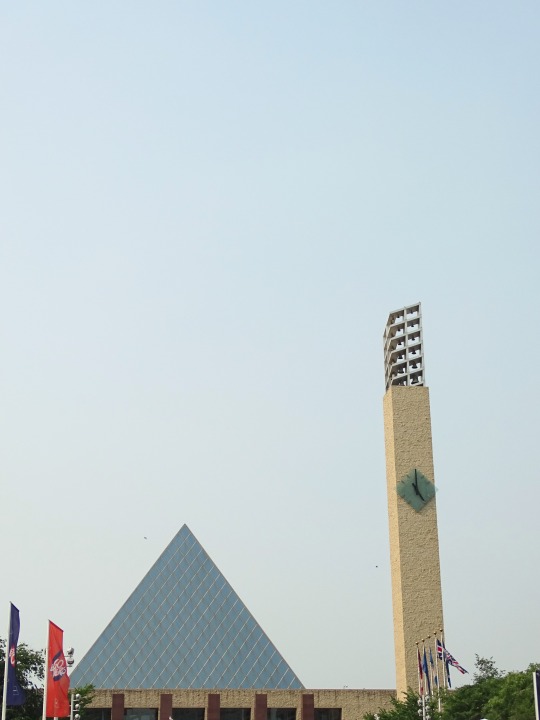



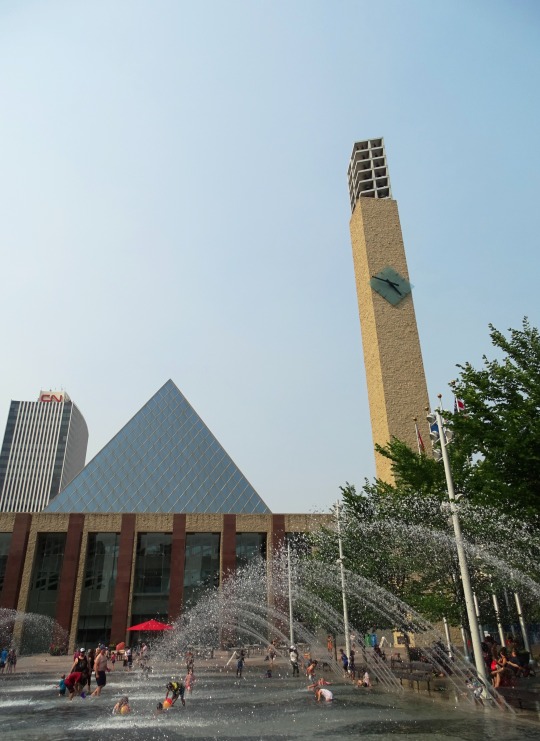

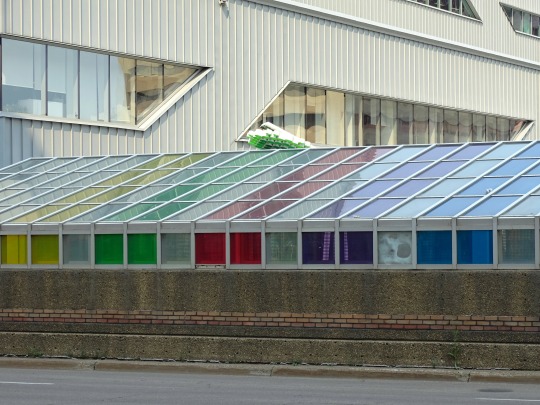

Churchill Square, Edmonton (No. 2)
Churchill Square (officially "Sir Winston Churchill Square") is the main downtown square in Edmonton, Alberta, which plays host to a large number of festivals and events including: the Edmonton International Street Performers Festival, Edmonton Fashion Week, The Works Art & Design Festival, Taste of Edmonton, Cariwest, and Edmonton Pride.
It is bordered on the north by 102A Avenue, on the west by 100 Street, on the south by Harbin Road (102 Avenue) and on the east by Rue Hull (99) Street. In 2009, 102A Avenue was closed to vehicle traffic permanently, providing easier pedestrian access to City Hall.
Surrounding the square are several cultural and governmental buildings, including Edmonton City Hall to the north, the Law Courts and the Art Gallery of Alberta to the north-east, Chancery Hall and the Francis Winspear Centre for Music to the east, the Citadel Theatre to the south-east, the Stanley A. Milner Library (the main branch of Edmonton Public Library) to the south and Edmonton City Centre mall to the west.
The centrepiece of the square builds a life-size bronze statue of Churchill, unveiled by Lady Soames on May 24, 1989. It is a copy of a statue made by Oscar Nemon.
Historically, Edmonton's main square was Market Square, located just to the south of Churchill Square, on the site of the present Milner Library. The City Market was housed in Market Square from its beginning in 1900, originally with the market happening outdoors. Successive plans were considered to develop the square into a civic centre, beginning in 1912. A building was built far away on 107 Avenue for the market to be moved indoors in November 1914, but was never used for this purpose and was boycotted by vendors and customers. The market returned to its original location and the city agreed to help construct a shelter. Beginning in 1915 the market was moved indoors, and by 1920 only overflow stalls were outside. From 1916, when the shelter was built, to 1965, when it moved off the site, the market flourished as the hub of Edmonton life. The City Market was finally shifted east to 97 Street, and the area was redeveloped according to a plan to create a "civic centre" in the area by constructing the new art gallery and library to accompany the new city hall which had been built in 1957.
In 1969, Lillian Shirt drew national media attention for protesting housing discrimination by erecting a tipi on the square. During the protest, which lasted 12 days, was joined by several others who set up tents and an additional tipi.
Churchill Square has undergone several face-lifts, the most recent, expensive, and most controversial, being completed in 2004, in time for Edmonton's Centennial Celebrations. These renovations saw the removal of a large amount of green space, as well as the building of several new structures in the square including an amphitheatre, a waterfall, as well as several structures for retail space (currently occupied by the Three Bananas Cafe and Tix on the Square).
Although Churchill Square is not the name of any street in Edmonton, and all the streets in the area are named, the square is used as the address for buildings facing it, they are numbered clockwise starting in the north.
Source: Wikipedia
#Churchill Wire Centre by Max Dewar#Sir Winston Churchill Square#City Hall Plaza#Churchill Square#Edmonton City Hall#Dub Architects#Edmonton City Hall Water Fountain#Art Gallery of Alberta by Randall Stout#Light Venturi by Terri Frost#fountain#public art#Alberta#Canada#summer 2024#travel#original photography#vacation#tourist attraction#landmark#cityscape#architecture#Edmonton#downtown#Friendship Tower
4 notes
·
View notes
Text
Homecooking [March ed]
Hiiiiii~
Rolling into spring with some spring rolls xD sorry, that was bad :P
Nothing much this month, I would say. Weather getting warmer. Sun out for longer. .. etc. I did a sketch of my favourite short tracker this season: Kim Gun Woo of Korea. I am watching a Kdrama called The Impossible Heir. Started strong, I caught up . .. & then the female lead kinda got on my nerves. I'm not familiar with her acting profile; however, I'm not sure how she got casted for this role. Were there no other options?! Anyway, you watch for yourself (& maybe let me know!).
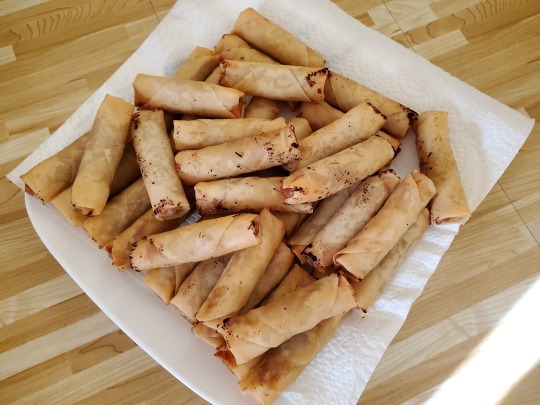
I ate out several times this month as well. In fact, I've eaten out the most number of times this month since the pandemic lol it's an achievement. Will work on those posts after this one! But for now. ..

The carbonara Samyang spicy chicken noodles WITHOUT the spicy chicken sauce. I've added some baby bokchoy, tofu & kimchi with it.

Kimchi pancake- I'm trying diff batters. This one was unsuccessful so I won't share. It was so. .. 'hard' =/
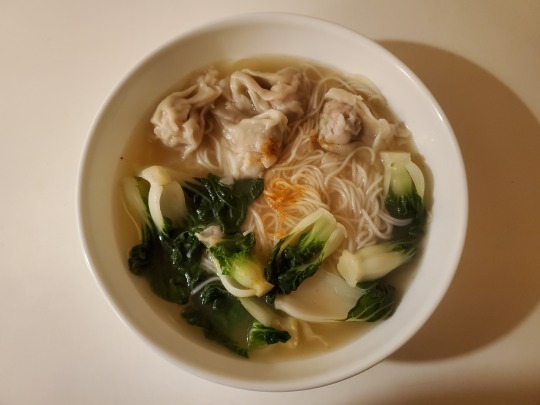
Homemade wontons with noodles & baby bokchoy.

Yes. .. more bokchoy -.-" this was thick rice noodles with hot pot fatty beef slices. Threw in some soup seaweed as well.

Pasta - for dinner, then leftovers for lunch the next day.
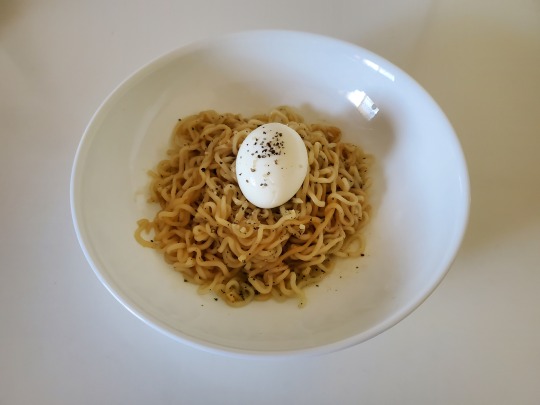
Also the carbonara Samyang spicy chicken noodles but without the sauce xD I keep the sauce for hotpots & stuff now.

Bro made fried chicken using a new batter recipe. It was alright.

"A little bit of everything" rice noodles - bean curd, bokchoy, napa cabbage (it's so pale in colour that you can't even see it), soup seaweed, kimchi, chicken. .. in a deonjang jjigae base.

Yeah I know, it's expired but it was still good. I smelled it haha I ate the Korean franchise congee recently ("Bon-juk" brand) & I was inspired to create something similar. I used this expired soybean paste soup sauce with another Hmart product that I've eaten before, instant vegetable-flavoured congee, & cooked the two together!
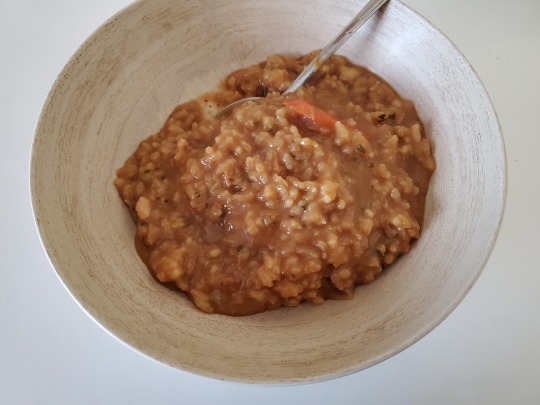
& it became this ^ soybean paste congee. It was actually very good! I had a little taste test while cooking it & it was way too salty (the instant congee pack is seasoned) so I added regular rice to it & more water . .. I essentially diluted out the contents. Ended up with way too much product lol oh well, leftovers, right? This was super successful. I would recommend it, especially if you wanna make a bigger batch & save some for later or if you are feeding 3-4 ppl.
That's all~ Bye byeeee~~
PS: I visited the Stanley A Milner (downtown) library for the 1st time since the renos were finished. I don't exactly know when the renos were done as I don't travel to that area often. ..
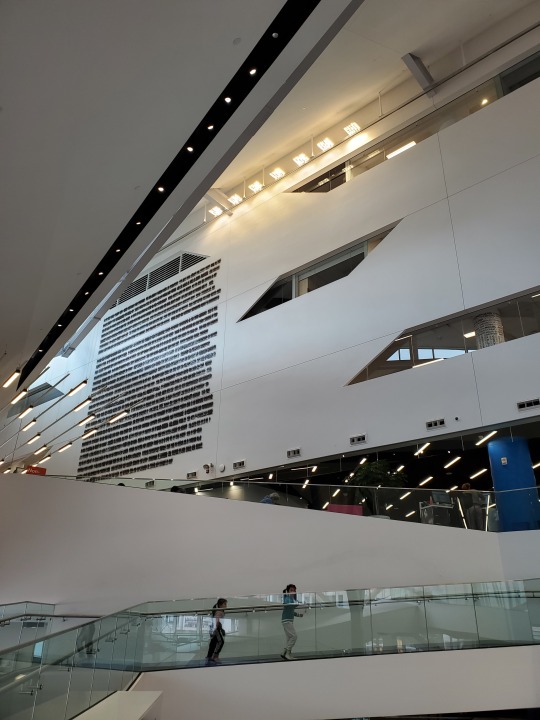
The atrium area between 2nd and 3rd level, feat. my nieces.

The facility was actually really nice! I remember spending time here when I was in high school . .. it was sooooo dim & the place was so old-looking. The most amount of time I was here was during extended essay writing period.. . had to read, write notes, & cite references for my paper, which was on Sun Yat-sen lol I don't recall the title of my paper anymore...been too long! But yeah. The library is very good-looking, with some really cool areas. The crowd. .. ughhh.. There was a strong security presence, which was good, I guess, but the amount of questionable ppl was also abundant. Sometimes I wonder if having a security gate/bag xray machine at the door would be a good idea. Of course, I acknowledge the fact that it's a "public" library but I also think measures should be taken to make all members of the public feel safe. Then again, if such measure was applied to a library, malls should get it too? *shrugs* Let's just say the facility was upgraded BIG time but the population hasn't changed.
Off I go to work on other things now :P seeeee ya!
6 notes
·
View notes
Photo

alberta queer history time yeehaw!!
so irresponsible of me to forget and I’m sorry this is last minute but here’s your pride-eve announcement:
Are you interested in 2SLGBTQ+ history? Do you need a little mental health walk after that shitty transphobe got elected in Ponoka? Can you be outside Edmonton City Hall at 5pm on Thursday, June 1st?
RSVP here for the free tour led by none other than former City Councillor (and one of the first openly gay politicians in the country let alone the city) Michael Phair to learn about how Edmonton was and is still being built into a safe and welcoming city for queer folks through the 70s, 80s and 90s to today.
in Edmonton this month but can’t make it tomorrow? don’t worry there’s More or you can pick up a free map to take your own self-guided tour from the Stanley A. Milner Library or download it straight to your phone
I know Calgary pride is traditionally in September but you can find out about Calgary Gay History’s upcoming walks here and find out where to get a copy of Calgary’s Queer Map.
#projectcanada cities#pc: edmonton#digital art#hapo doodles#clip studio paint#boab illustration#boab announcement#will i be there will i be wearing purple very possible lol#edward murphy
24 notes
·
View notes
Text

had this drawing of the Stanley A. Milner library half done for like a month so I finally finished it today. I have mixed feelings about how the drawing came out, but it is an interesting and difficult subject.
I left Edmonton to study while it was being built and came back for its belated opening and I remember the anticipation and the public backlash about how it looked, but I think it looks really cool (the imperial star destroyer comments made me laugh). I think the main library branches of E town and Cowtown have such polar opposite aesthetics that are so interesting.
8 notes
·
View notes
Text
Mission: Mural Rescue – Conserving 50 Years of Edmonton Public Art
This is the first installment of a multi-year project which will be documented on the YEGArts blog

(Buckets of equipment)
On a freezing afternoon in February, the Edmonton Arts Council Conservation lab, tucked in the corner of a west-end industrial park, looks like Command HQ for a complex recovery operation. Rubbermaid tubs full of equipment – spray bottles, brushes, knives, tissue paper – are neatly stacked next to plastic sheeting cut in complex shapes, and protective apparel. Public Art Conservator Andrea Bowes is busily diluting odiferous bottles of Lee Valley Codfish glue, while Conservation Director David Turnbull scans his workplan for what could be the most complex project ever undertaken by his department.
Their mission is to remove, restore, and reinstall a 50-year-old, 1600 square foot, 10,000lb mural. The untitled artwork, created by Alberta artist Norman Yates in 1967, is painted directly on a semi-loadbearing wall in the Stanley A. Milner Library Circulation Department on the main floor. The location places the artwork directly in the path of the extensive renovations which will reshape and transform the building, so the team is working against the clock to remove the art.

(Mural section)
“This is the only known surviving artwork in Edmonton’s Public Art Collection commissioned for Canada’s Centennial, so I feel we’re preserving an important part of Edmonton’s art history,” says David. “Norman Yates was an important artist in the city. He founded the graduate program in the University of Alberta’s Department of Fine Arts, mentored generations of artists, and before he died in 2014, also kept up a thriving art practice.”

Born in Calgary in 1923, Yates studied at the Ontario College of Art and Design following service during World War II with the Royal Canadian Air Force. Following graduation, he taught at the college for three years before accepting a post at the University of Alberta in 1954 where he taught for 33 years.
The mural under conservation is one of Yates’s “landspaces” a technique he devised for painting sprawling, almost three-dimensional paintings of the Canadian landscape. Students and visitors to the University of Alberta campus are very familiar with one of his largest works, North and West on the north wall of the Education Building on the U of A campus. The Centennial artwork in hues of green and blue, is a smaller hidden treasure.

(Back of the mural)
“A large part of conservation is planning,” remarks David. “This is a hugely complex project. The mural is painted on plaster that was applied directly onto a concrete wall; there is a 2-foot gap between the back of the mural and cinder block wall so there is little room for maneuvering behind the structure; the entire mural must be cut and moved in sections while preserving the inch or so of plaster it’s painted on. In addition, the work is physical, uncomfortable, and hot. So, success is not just about what are we going to do, but how are we going to do it?”
The first step is preservation of the artwork surface. David and team researched different methods of mural restoration and removal, and settled on a version of the Italian stacco a massello method. “…it was developed in Italy for removing frescoes. You take canvas and a lot of adhesive. Essentially you glue the fabric to the face of the painting and then you bash away the backside and the material holds the front and you are literally the art component. But you destroy the architecture; the art would be put on another support and reinstalled somewhere else.”
“What we’re doing with the Centennial Mural is, to quote M*A*S*H, a bit like delicate meatball surgery – we’re stabilizing then evacuating so we can do the real surgery later.”

To preserve the Yates mural, the team spent a week facing the artwork with a layer of Japanese tissue paper and the thinned-out fish glue. “We cut the tissue in 1 foot squares,” explains public art conservator Andrea Bowes. “We then placed one piece of paper on the mural surface, painted it with water and then cross-grained a second layer over the first with glue. As we go along we also overlapped the edges to give more strength. That way, if some of the paint gets dislodged when we remove the mural, the tissue will hold it in place. We are using the Japanese tissue because it has long strands which make it incredibly strong despite its lightness.” The team can then tease off the tissue facing with water and paintbrushes.
youtube
Getting the mural from Edmonton’s downtown to west end is the next challenge. Painted on plaster applied over a cement wall, the mural is incredibly heavy. There’s no room for a crane or large team of workers, so the three conservation experts must remove it in sections. “Andrea calculated that a 4X8 section of the mural and wall will weigh about 2000 lbs,” says David. “With removing the excess concrete and metal mesh that’s behind the artwork, we hope to cut down that weight quite a bit, but it’s still going to be substantial. So, we’ll have to cut out sections in manageable sizes. There’s going to be a lot of grunting and groaning!”
Cutting the mural into a grid would make removal easier but the conservation team is going to let the artwork itself dictate the cut lines. “There are natural lines where there are colour shifts and within the pattern itself so if we follow them as much as we can and cut into the natural lines, we can limit the amount of restoration work we may have to do later.”

(template detail with Norman Yates signature)
The team traced the artwork shapes and patterns onto thick plastic sheets which have been used to make plywood formwork in the shape of each section and then lined with foam. “We’ll place the forms on the face of the mural with the foam facing inward so the paint is protected. Then we’ll sandwich the mural with lumber from the back so as the old supports are removed, it doesn’t just fold and crumble. The last step is to pull the section out, lie it face down, and high fives all around!”

(The team has about 2 feet of space to work in behind the mural)
Complimented on the brilliance of the plan, David cautions; “It’s all theoretical, we’ll have to go through a few sections to make sure this is feasible and if not, change direction on the fly! It’s going to be hot and uncomfortable work - there isn’t a lot of air movement and a lot of dust, so we’ve brought in an air handling unit. This is really the same principle as excavating a dinosaur skeleton; how they stabilize the bones, cover them in plaster and undercut, then dig out from underneath.”

(First section removed successfully)
The test piece is successful, so the team will continue with the plan. Once the mural is removed like a giant jigsaw, it will be transported to the lab where the painstaking work begins. “First we’ll remove any residual substrate so we’re left with just the plaster which is about an inch thick. Then we’ll attach the sections to a lightweight backing like an aluminum honeycomb – something with a lot of dimensional stability and strength. After that we’ll tease off the tissue paper facing and repair and restore the surface. The last step will be to engineer a hanging system and a way to reassemble the artwork with the least amount of onsite restoration.”
The entire process will take about three years with the intent that when the construction crew is completing final fit-up for the Milner Library, the conservation team will be able to install the mural in its new home.
Asked what he believes the entire journey will entail, David shrugs and grins. “A lot of adapting on the fly, changing plans, and figuring out what’s going to work and not work for the sake of the artwork. There are so many unknowns that you just have to deal with it as you go... and a lot of chiropractic visits!”
2 notes
·
View notes
Text


If you have the chance to visit the Stanley Milner Library in downtown Edmonton you should absolutely check out the Seeds portraits there which features Holocaust and Residential school survivors. Very powerful.
2 notes
·
View notes
Photo

November is Edmonton Housing Month. I saw Laura’s story in the Milner Library parkade, emphasizing the importance of Housing First. #yeg #yeghousing #yegdt #housing (at Stanley A. Milner Library) https://www.instagram.com/p/Ckdatz8LORT/?igshid=NGJjMDIxMWI=
0 notes
Photo

Lego Librarian has been itching to visit the Edmonton Public Library #stanleyamilnerlibrary in #downtownedmonton #edmonton #legolibrarian. It was great! It had a #seedlibrary, #makerspace area and a huge big screen monitor showing an undersea seen. #imagine #legolibrarianexplores #legolibrarianexploreslibraries (at Stanley A. Milner Library) https://www.instagram.com/p/CfmDZLOLsTv/?igshid=NGJjMDIxMWI=
#stanleyamilnerlibrary#downtownedmonton#edmonton#legolibrarian#seedlibrary#makerspace#imagine#legolibrarianexplores#legolibrarianexploreslibraries
0 notes
Photo

Working on a video for work this morning. I won’t spoil it, but I had a blast with our crew and I did all my own stunts. (at Stanley A. Milner Library) https://www.instagram.com/p/Ccv3AVeuZ36/?igshid=NGJjMDIxMWI=
0 notes
Photo

This guy got to be in an art show at the downtown #library . The Isolation exhibit of covid art. Go check it out to see all its glory! Also check out how cool the library is. #yegartist #yegartshow #stanleymilnerlibrary (at Stanley A. Milner Library) https://www.instagram.com/p/CZYU0ElAvzE/?utm_medium=tumblr
0 notes
Link
1 note
·
View note
Photo

C’est une bibliothèque canadienne qui fait la page couverture du Library Design Showcase 2021 : la Stanley A. Milner Library à Edmonton en Alberta est une bibliothèque publique avec une attitude et des convictions for sure. #sci6002 https://www.instagram.com/p/CTNt06rntKN/?utm_medium=tumblr
0 notes
Text
Lessons of the pandemic
This past 16 months or so, I’ve learned a lot as the restrictions imposed by the COVID-19 pandemic changed my life:
I can setup a near-ideal computer/multi-monitor configuration without additional purchases and discreetly run Ethernet cable for a wired home network
We have enough devices/screens for the three of us
Still much of Edmonton is unexplored (for example, newly discovering Terwillegar Park, Grandview) and exploring the areas within the city is almost as interesting as travelling outside the city, but unfortunately we still come back to the same messy house
There is a wealth of materials in the public libraries around Edmonton, especially the TRAC network of smaller municipal libraries
It’s important to have access to public washrooms and safe havens like libraries, coffee shops, fast food restaurants. Longer cycling rides need a destination
While library "take-out service" is adequate, often there are unexpected finds when browsing a library
With the closing of my company’s physical office space and the extended limits on public access to the newly renovated Stanley Milner library, I missed the usage of its fabulous new facilities
Due to the reluctance to have contractors enter the house and things getting older and breaking down, there were many more DIY opportunities, some that were missed (central vacuum power head) and some taken (resolving flat bike tires, temporary kitchen drawer fix, dishwasher diagnosis and installation)
I miss Yang Ming but still get to eat a variety of good food at home, but eating at home is not as enjoyable without a working dishwasher
Napping for 10-20 minutes during the day is very rejuvenating
Possibly due to practically not using public transit at all, I have a renewed interest in cars. Another reason may be due to driving my son to school rather than him taking the school bus, and seeing what vehicles all the other parents are driving
The couch in the basement is very comfortable for sleeping on
Despite a significant amount of time devoted to my father when he was alive, now that he’s passed away, why is there still so little time?!?
0 notes
Text
Stanley A. Milner Library
My flight arrives a Sunday morning, and by the afternoon, I manage to reach the lobby of the library. A kind, chatty librarian proudly shows off The Wall. she much prefers the serenity of the coral reef which is playing on The Wall today (tomorrow will not be so tranquil). She suggests the audio tour, and she emails me a link to the files on the website. Sounds like a great idea, but I left my earphones at the hotel. I will go back and get them.
I don’t make it back to the library until the next day. I am dreadfully hung over from meeting up with Janine for Sunday tea (by which I mean beer and appys) and then with drinks Mark after the Zoom meeting (it became clear later that he was passing the time before he paid a booty call to his much younger girlfriend).
Anyways, the audio tour is disappointing. Facts and statistics without context, and a list of the spaces and their intended uses, but nothing insightful about the architecture and interior design.
The architecture reminds me of the Surrey Central library - airy.
There is a movie studio and music studios - reminds me of the renovations of the VPL central branch.
I am drooling over the 3D printers in the Makerspace (currently in use) and the Alienware rigs in the Gamerspace (currently closed).
I am sure that books and magazines - printed reading material - account for a fraction of the space and of the capital budget. I’m certain that the notion of a ‘library’ resonates emotionally with taxpayers and parents. Any politician who tries to cut funding to something that goes by the name ‘library’ would be pilloried in the media. And parents who worry about what their kids are doing are soothed by the name ‘library’. But this is not primarily a ‘library’, in the sense of ‘a place for books’. Perhaps we should rather call this a community centre, for playing video games, surfing the web, make music recordings, use power tools.
0 notes
Text
Things I Knew To Be True: Meditation as modern-day transcription

Things I Knew To Be True by Peter von Tiesenhausen. Photo: Laughing Dog Photography.
Things I Knew To Be True has been a 20 year meditation for artist Peter von Tiesenhausen. To say the sculpture is impressive would be an understatement. Made up of 822 individual pieces, not including the 4,000 hand-cut-and-welded wall mounts, it is affixed to the wall of the Stanley A. Milner Library in the shape of a 28-foot-tall paragraph. The catch is, Peter’s sentences are not written in traditional words. They take the shape of abstract human figures, all conforming to the same basic structure, but with entirely different meanings.
Peter von Tiesenhausen began this project two decades ago when performing the unceremonious task of ripping up old floorboards. As he worked, he discovered unique grooves in the undersides of the boards and began to char and whitewash them. Noticing how the paint chipped in irregular ways, Peter started to carve his thoughts into the boards.
“What is it I want to say today? I’d think, and then I’d take maybe an hour to scratch in two or three sentences, accounting for spelling mistakes, and trying to remember what the sentence actually was,” Peter recalls. “There was no reference, it was a meditation.”
Peter has lived within a mile of his current residence in Northern Alberta for most of his life. It’s as if the land has carved itself into him as well. The forest surrounding his property was devastated by a fire around 1907, and he has had the opportunity to watch it grow.
“Part of my job as an artist is to observe, and I was seeing so many changes to the landscape. Nature blossoms and diversifies on its own. You have no choice but to cherish the richness,” says Peter. The migration from paintings to sculpture became a conversation with the land, expanding his observations. Paintings are distanced — a moment in time — whereas sculpture are more of an interaction.
Art has always been a big player in Peter’s life. At an early age, he remembers visiting family friends and bringing over a pencil and paper. “It seemed like magic to me to watch them create something out of nothing.” Growing up, Peter worked as a gold miner, an oilfield worker, and on an airstrip for the British Government in Antarctica. It was on a boat trip from Antarctica to South America that he met Joe Farman, one of the scientists who discovered the hole in the ozone layer. “Keep in mind, this was the 1990’s, and I wasn’t necessarily aware of any of this. We had two weeks to discuss CFC’s and the like. It became so clear just how finite the world was and that this could all come to a head within my lifetime. It was impossible not to notice the damage being done.” Peter quit his job in Antarctica at the age of thirty and committed himself to being a full-time artist, fulfilling a long-standing goal. While making impactful art with the least environmental impact has been largely in focus throughout his 32 year career. Peter posits, “Maybe it’s not my job to tell people what to think, but to make the most powerful art I can, in evocative ways, so people can think on their own. Maybe I can make something that will encourage engagement the way I was engaged.”

Detail of Things I Knew To Be True. Photo: Laughing Dog Photography.
When the commission for the Stanley A. Milner Library was proposed, Teresa —Peter’s partner — suggested that he submit “the text project”. Thus began the production of Things I Knew To Be True. Peter hired his sons and constructed a separate building on his land, purpose-built for this sculpture. Standing by his mandate of how to create art in the least impactful way, he installed 32 solar panels, generating ten kilowatts (10,000 watts) of solar power to fuel the necessary machinery, which now also sustains his house and car. “The whole thing keeps growing into the next step. It came to fruition because of this project and managed to help us step up to a different way of living, which is now less impactful to the planet,” says Peter.
Things I Knew To Be True then took the form of a modern-day transcription. The original charred boards were photographed, photoshopped, and projected onto discarded steel sheets Peter had collected from a fracking company. “I freehanded my words onto the rusty steel with chalk. I did actually consider getting a tetanus shot afterwards,” he chuckles. From the earliest etchings from Peter’s mind, to one of his son’s skills with a plasma cutter, the words took shape and each translation altered their meanings. “I don’t even remember what the words mean anymore. My hope is that the viewer can sit with this paragraph and put their own words into those spaces. I’d like to create a text that is open, unifying rather than divisive. Is there a possibility for the viewer to reflect on what they’re actually thinking instead of what they’ve been told?” Perhaps all the things we knew to be true are exactly the same.
10 notes
·
View notes
Text

One of my favourite things about Vancouver after the Ocean and the Mountains is the abundance of public art. You can find it on most street corners downtown and always in pubic parks. My favourite piece is the A-maze-ing Laughter found at English Bay. Visiting Vancouver turned me on to public art in a way I never noticed in Edmonton.
Some people I know usually talk about art in terms of its stupidity or waste of money. Someone always has an opinion on how to spend tax dollars better. I think public art is culturally important. It helps identifies us as a people who recognize the value arts brings into a community. No doubt art is subjective. You either love it or hate it but its intent is to make you feel and start a conversation.
In 1991, Edmonton passed a policy called Percent for Art. Currently, Edmonton allocates 1% of the qualifying construction budget of any publicly accessible municipal project (% project) for the procurement of art to be publicly displayed. The Edmonton Arts Council is the steward of this program. I never thought of Edmonton as a city invested in the arts, I looked at the public art in Edmonton as an element of design – not a city being deliberate in supporting the arts. Then I stumbled upon THIS WEBSITE. It is an online gallery of all the public art in Edmonton.
It was as if I woke up.
That meant the giant shoes at the Southgate LRT were deliberately put there as public art. The Talus Dome, arguably Edmonton’s most controversial art installation is also a part of this program. “Before the Quesnell bridge was constructed, talus forms of earth occurred naturally along the river valley. The artwork reminds us of the landscape that has been altered by the bridge, a rigid, controlled construction that meets our need to traverse the obstacle of the river. It refers to the coexistence of the man-made and the natural.” Okay – so there is significance to the sculpture. It was all coming together for me.
As I scrolled through the City of Edmonton Public Art Gallery, I decided to tour my ‘hood and check out the different pieces of public art. I am guilty of travelling to the river valley far too often to explore Edmonton and I never looked at my neighbourhood as a place to tour. I made a list of the public art pieces in my neighbourhood and spent an afternoon exploring. My East-West grid was 17 street – 91 street. My North-South grid was Whitemud Freeway to Ellerslie Road.
Landscape Series 1 by Erin Ross was my first stop. This installation is located at Mill Woods Park on the northside of the building by the football field. All prairie paintings that showcase Alberta skies.
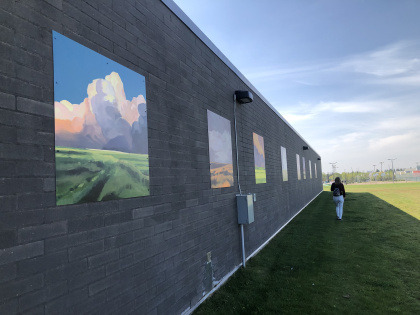
Next stop was Mill Woods Public Library for three separate installations.
Jordie Bonet’s Untitled. 10 panels each weighing over 2000lbs. Can you imagine the undertaking it took to install this piece? It was originally located at the Cenntenial Library before it became the Stanley Milner. This is located in the fiction section on the east side of the library.
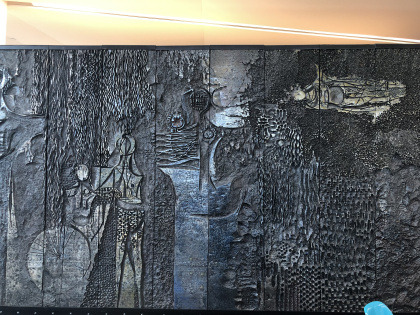
This next piece, Phantasien by Tim Edler and Jan Edler is inspired by The Neverending Story. It is a study room clad in mirror with coloured lights. Its kind of trippy and students were studying in it. But I can see the appeal of being in there. Art can be functional too.
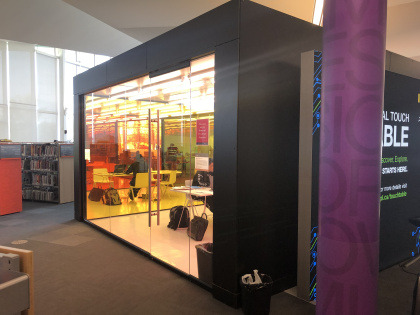
Upstairs in the Mill Woods Senior Centre is Milled Wood by Destiny Swiderski.
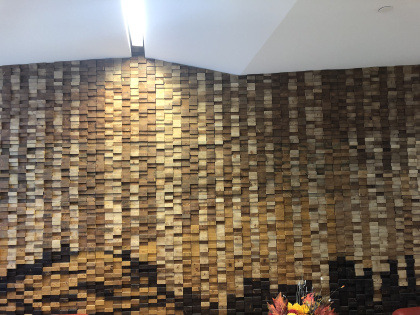
After leaving the Library, I travelled a block away to the South Division Police Station to see the nine canvasses of Encompass by Allen Ball.
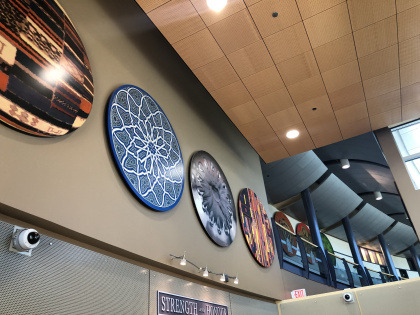
Then off to Ivor Dent Sports Field to see Inspiral Arches from one of my favourite artists, Dylan Toymaker. If you have been to Victoria Oval or the Flying Canoe Festival and have seen the light installations, then you are already familiar with Toymaker’s work.
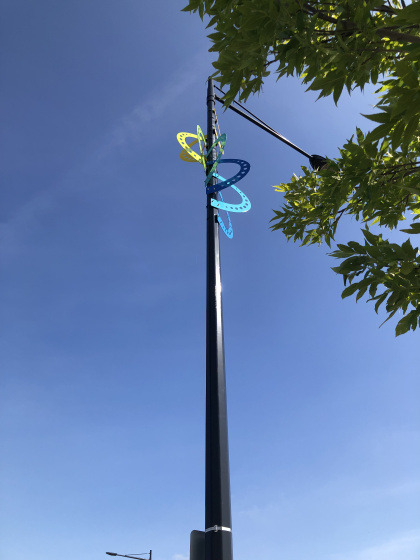
It was time to go closer to home and visit the Meadows. The Meadows Recreation Centre and Public Library also has a couple installations. My favourite is Wheatfield with Crows by Konstantin Dimopoulos. I love how it sways in the breeze just like wheatfields.
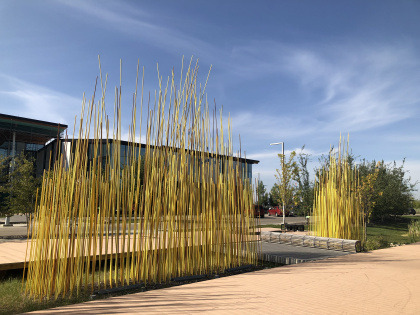
Inside the library was Sculpture in Landscapes by Cliff Eyland. Catalogue card-sized landscapes. This was a cool choice for the library.
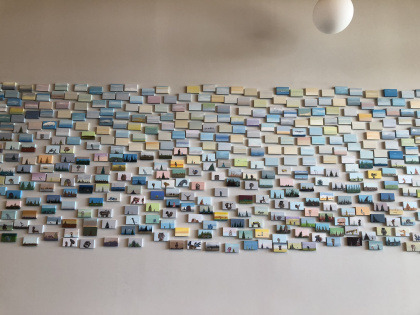
And finally, Parade 1 by Gabe Wong (Parade two is aquatic animals located at Lewis Transit Centre) located on the west side of the Meadows Transit Centre. The ladybug is my favourite.
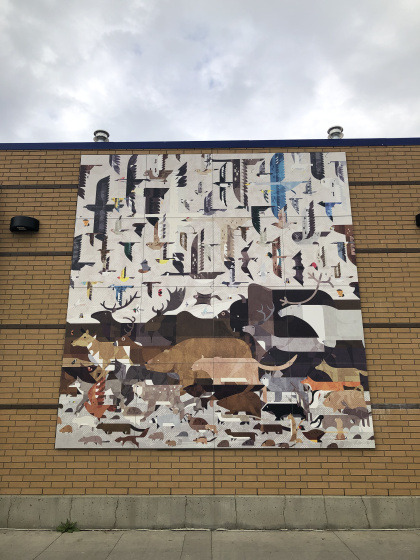
Wandering around my neighbourhood gave me a better appreciation for where I live and the fact that we have art accessible to everyone thrills me. I wonder who notices it? Let me know your favourite Edmonton Piece – maybe I will visit it next!
Edmonton Tourist: South East Public Art One of my favourite things about Vancouver after the Ocean and the Mountains is the abundance of public art.
0 notes